#translation verification process
Explore tagged Tumblr posts
Text
Comparative Review in Translation Services and Language Services
Understanding Comparative Review in Translation Services Whether you’re a seasoned translator or simply curious about the translation process, this blog offers invaluable insights. Understanding how translations are evaluated is crucial for maintaining high standards and ensuring accuracy. One key method of evaluation is the comparative review, a process that compares multiple translations of the…

View On WordPress
#comparative language analysis#Comparative review in translation services#effective translation comparison#multilingual translation review.#professional translation review#side-by-side translation comparison#translation accuracy review#translation assessment services#translation comparison methods#translation consistency check#translation error analysis#translation evaluation techniques#translation fidelity review#translation quality assessment#translation quality control#translation verification process
0 notes
Text
🎧A Guide to the TGCF Audio Drama🎭
With the release of the new season of the fabulous TGCF audio drama, I wanted to make an updated guide on how to make an account, purchase, and listen (with English subs) to it! Hopefully, this will help more people enjoy it and join in on the fun!
As a quick reminder, the audio drama is based on the revised version of the novel! It's a very faithful adaptation, but if you're a new fan, that might throw you for a loop! If you need an overview of the different versions of TGCF, check out this post first!
Part One: Making an Account & Purchasing
The process is a lot easier than you may expect! The site where the audio drama is hosted is "missevan.com," also known as "MaoerFM." They are one and the same!
Check out these infographics to create an account and buy the audio drama. (Due to tumblr compression, they may be difficult to read. If this is the case, please view these images in full-screen and preferably on a web browser for best quality!)


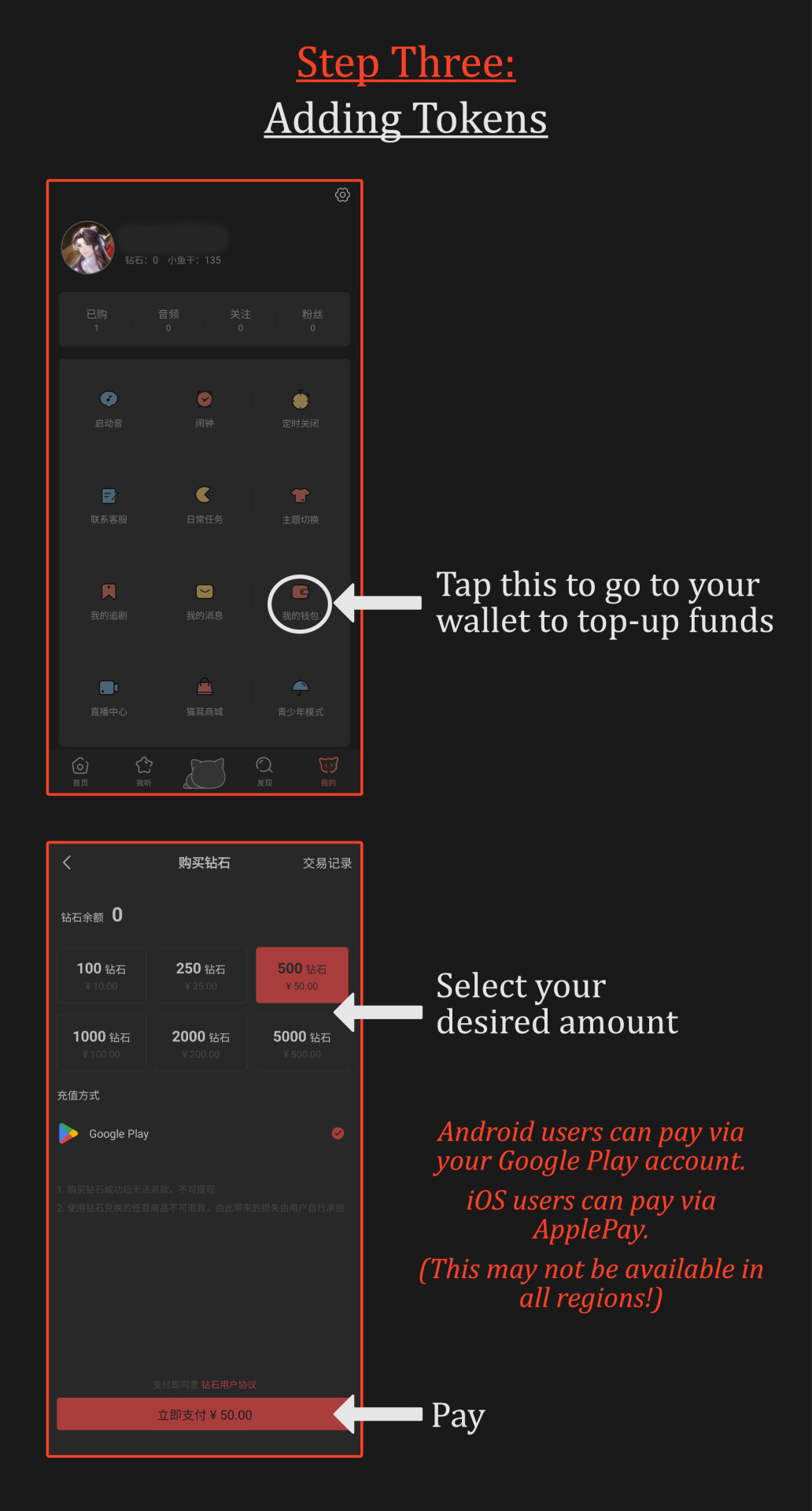

ADDITIONAL INFORMATION
General Info:
It costs 319 diamonds for the first season, and 359 diamonds for the second season of the TGCF audio drama. This was less than $5 USD, for each season. Future seasons will likely be similarly priced.
Episodes typically release weekly. Mini-episodes/bonus content releases intermittently, and often continues after the main season "ends."
This guide will work for any other audio dramas you want to purchase and support (such as MDZS)! They obviously have different costs, but the process of buying is pretty much the same.
Account/Registration Info:
If you do not see your country/region code listed when making an account, it is unfortunately unavailable there. I do not know any workarounds at the moment, apart from asking a friend/relative in a different country to help you out! If anyone does know other options, please let me know!
Step One of the guide is technically optional, as logging in on the app for the first time will automatically create a new account, if there’s not already one associated with your mobile phone number. I recommend doing that step anyway, as it will ensure that you have a password linked to your account. Several people in the past have reported that they sometimes cannot receive the verification code to log in. (Especially from South America and SEA for some reason.) Having a password bypasses this, if it happens to you.
Unfortunately, it seems that you MUST register with a mobile number to begin with.
Otherwise, you can use an existing Bilibili/QQ/WeChat/Weibo account if you have it. They all require a number for registration too, as far as I know, so you may run into the same problem. They may still be worth trying if you have no other options! Once again, if anyone is aware of other workarounds, do let me know.
Additionally, it’s possible to link your account to an email AFTER you register with a mobile number. (There’s no escaping that, from what I can tell.) You can then use that to log in.
It seems useful to have your email and a password associated with your account, especially in case your country code gets nixed from availability -- which has been known to happen without warning in the past.
The mobile browser seems to prefer you log in with a number/email and a password, rather than a verification code.
LINKING AN E-MAIL TO YOUR ACCOUNT (Optional)
This must be done via web browser, or with your mobile browser set to desktop mode. It’s VERY easy if you use a browser with an auto-translate feature like Google Chrome:
(These images are the MTL translated versions!)

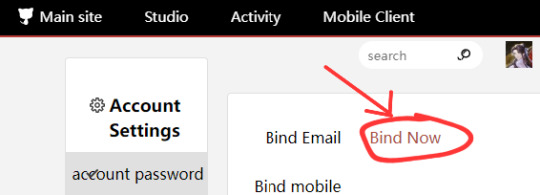
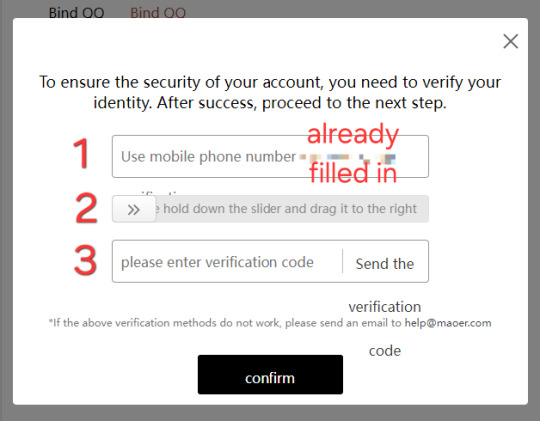
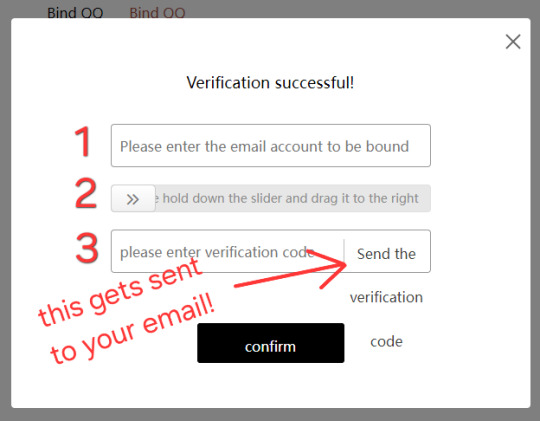
Unfortunately yes, you will need to receive a verification code via mobile number to enable this. The second verification code gets sent to your email, though! (Try not to lose your password, because I'm pretty sure you'll still have to use your phone to verify and change it.) Don't forget to check your spam folder if you don't see it. It will be from "猫耳FM."
Once again, this is optional! I just wanted to include it as an extra avenue for people who may struggle with the verification codes, as they can be finicky. And it happened to me while I was making this section, so I knew I had to....
Part Two: How to Enable English Subtitles
First things first: there are no official English subs for the TGCF Audio Drama. Though I'm fairly sure this applies to all dramas on MaoerFM.
However, there are Chinese (Simplified) subs for each episode.
OPTION ONE: MTL
The main method that non-Chinese speakers have been using to understand the Audio Drama is via MTL (machine translation) on those subs! Browsers like Google Chrome not only have auto-translate, but it works in real time as you watch/listen to the episode.
Make sure that it's turned on and that you've selected English -- or your preferred output language!
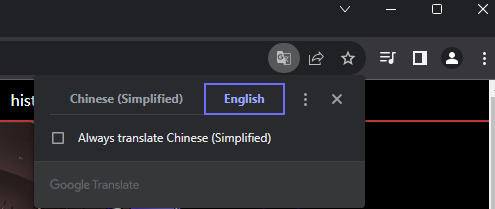
Be aware there are TWO types of subtitles on MaoerFM. There are the official subs, and the temporary subs.
At the bottom of the audio player, there is a button labelled "字幕," which is circled in purple in the image below. If it is there, it means that episode has official subs available, and you can toggle them on/off. Meanwhile, the "弹" that the green arrow is pointing to is known as the "barrage." That's the scrolling text that you will see filling the screen. It's other fans screaming and crying in chat. You can turn it off if it feels overwhelming!

New episodes may take anywhere from a few hours to a day or two to be officially subtitled. (The bonus episodes don't have official subs for whatever reason.) In the meantime, there will be subtitlers working on adding temporary subs! I'd advise waiting a little while before listening to a new episode so they have more time to work, and you'll have better coverage!
While official subs are entirely separate, the temporary subs are part of the barrage. So you will have to keep the barrage turned on. (Notice how there is no "字幕" button next to it yet!) Unlike the rest of the barrage, the subs will be stationary, color-coded, and at the very bottom of the window -- so they're easy to differentiate.
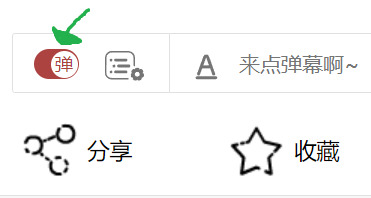
However, since the barrage can be a lot if you aren't used to it, there is a way around it.
Hit the settings menu (blue circle) and block the scrolling comments. You can also turn off the top ones, but just make sure not to turn off the bottom ones -- because those are the subs!
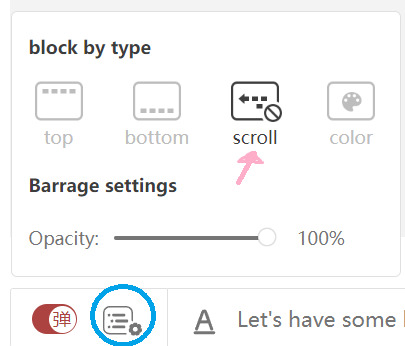
DO NOTE that this all works best on desktop! If everything's gone correctly, you should have something like these:
Right -- regular view, temporary subs Left -- full-screen, official subs
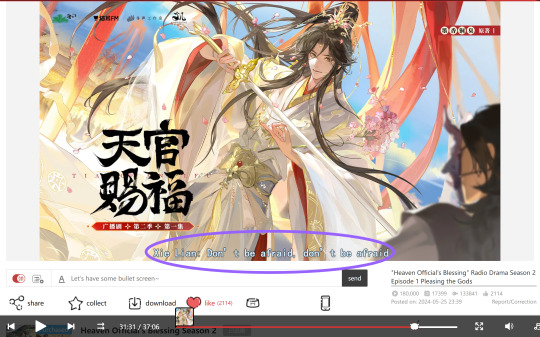

It's possible to get this to work on mobile if you enable desktop mode in your Chrome app. You will probably need to refresh a few times after that, or open the page in a new tab to have it work properly. Then it's the same steps as above!
You should have something like these:
Right -- landscape mode Left -- portrait mode
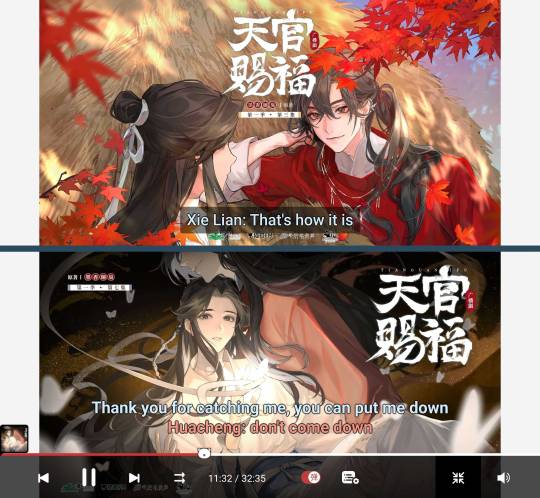
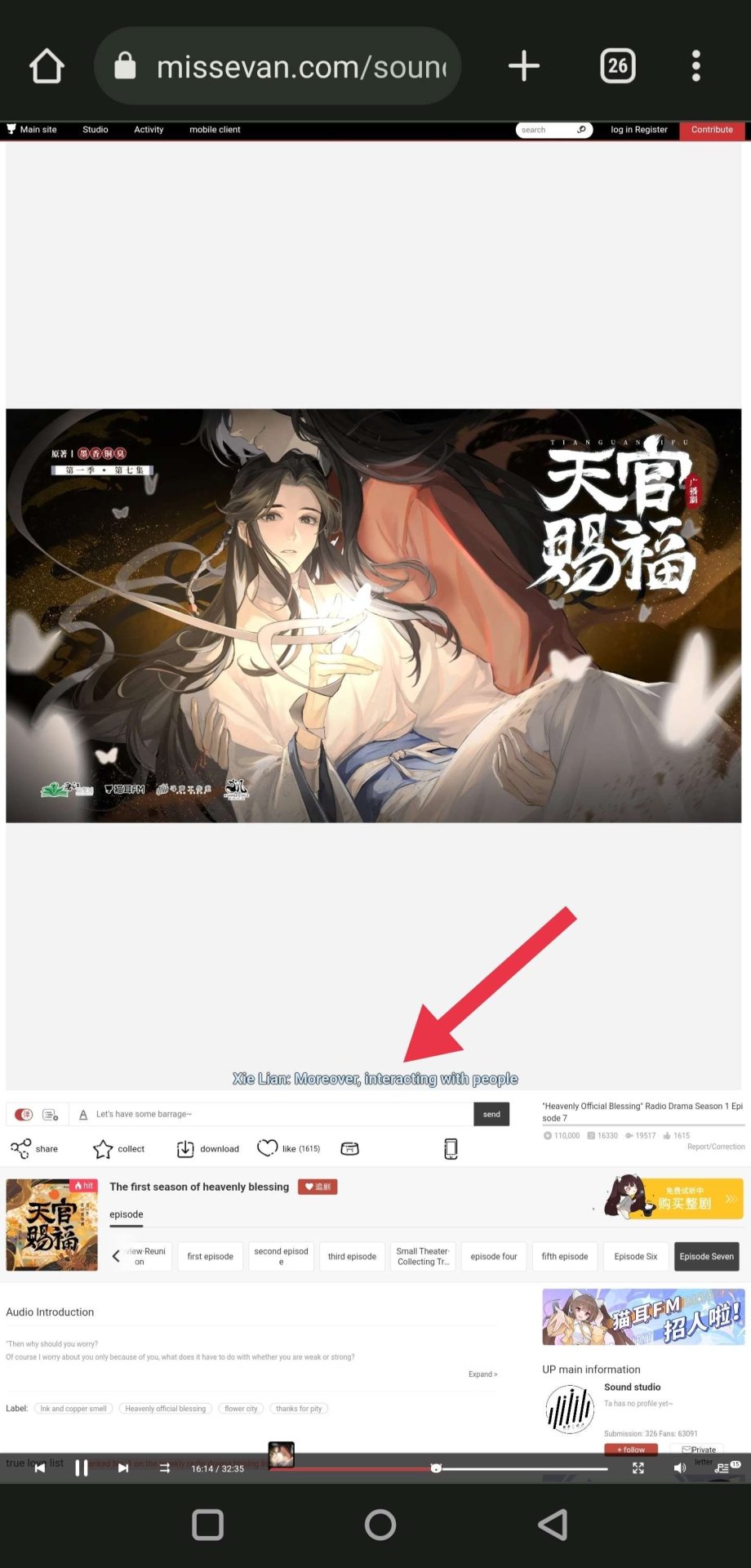
The scaling on mobile can be troublesome, and I have noticed that the auto-translate is slower than on desktop. It seems to take an extra second or two to work on each line -- whereas on desktop it's pretty instant -- and that can get annoying, especially in fast-paced scenes.
Additional Info:
This does not work for the mobile app! It is for the website ONLY!
If the translation stops working, refreshing usually fixes it.
There are potentially other options to using Chrome. Any browser that has an auto-translate will work, assuming it's as quick as Chrome's. If anyone has tried other browsers and seen success, please leave a reply!
OPTION TWO: FANSUBS
TreasureChestSubs here on tumblr have been doing high-quality fansubs for several audio dramas, including TGCF as of recently! However, at the time of making this guide, their TGCF translations currently only cover the first few episodes of season one. You will need to request an invite to their Discord server via the form in their posts. Please do check them out if you're interested.
I don't personally know of any other fansubbers who are actively working on the audio drama right now. But I do want to mention that Xyra_Rei on twitter has a Discord server where they share some translated snippets from various episodes. There are other great resources by fellow fans, too. Links and more info about the server can be found in the pinned post on their profile!
Part Three: Enjoy!!!
I hope this updated guide helps more people experience the wonder that is the TGCF audio drama (or really, any audio drama)! I cannot overstate how good it is in every aspect, and I think every TGCF fan deserves to be able to hear it for themselves! 💖
#tgcf#tian guan ci fu#hob#heaven official's blessing#tgcf audio drama#guide#nyerus.txt#yes fellas this is my only use-case for chrome and tbh... lmk of other options please lol#anyway the TGCF AD has my entire heart and soul PLEASE LISTEN TO IT
266 notes
·
View notes
Text
Me in 2053 with my future-wife showing her some bread I made for her because I adore her: I loaf you future-wife.
Her: stop calling me your future-wife this is the present for us. I am your present-wife. Just because I can shoot lazers from my eyes and have a universal translator chip in my brain doesn't make me more future than everyone else.
Me, not listening because I was mentally logging into our toaster with a 5 step verification process and I had to watch an unskippable ad while the toast was toasting which overtook my vision and audio processors: my beautiful future-wife, i toast you
248 notes
·
View notes
Text
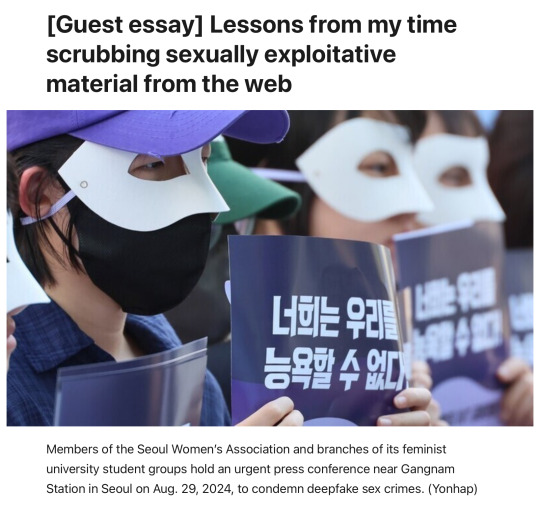
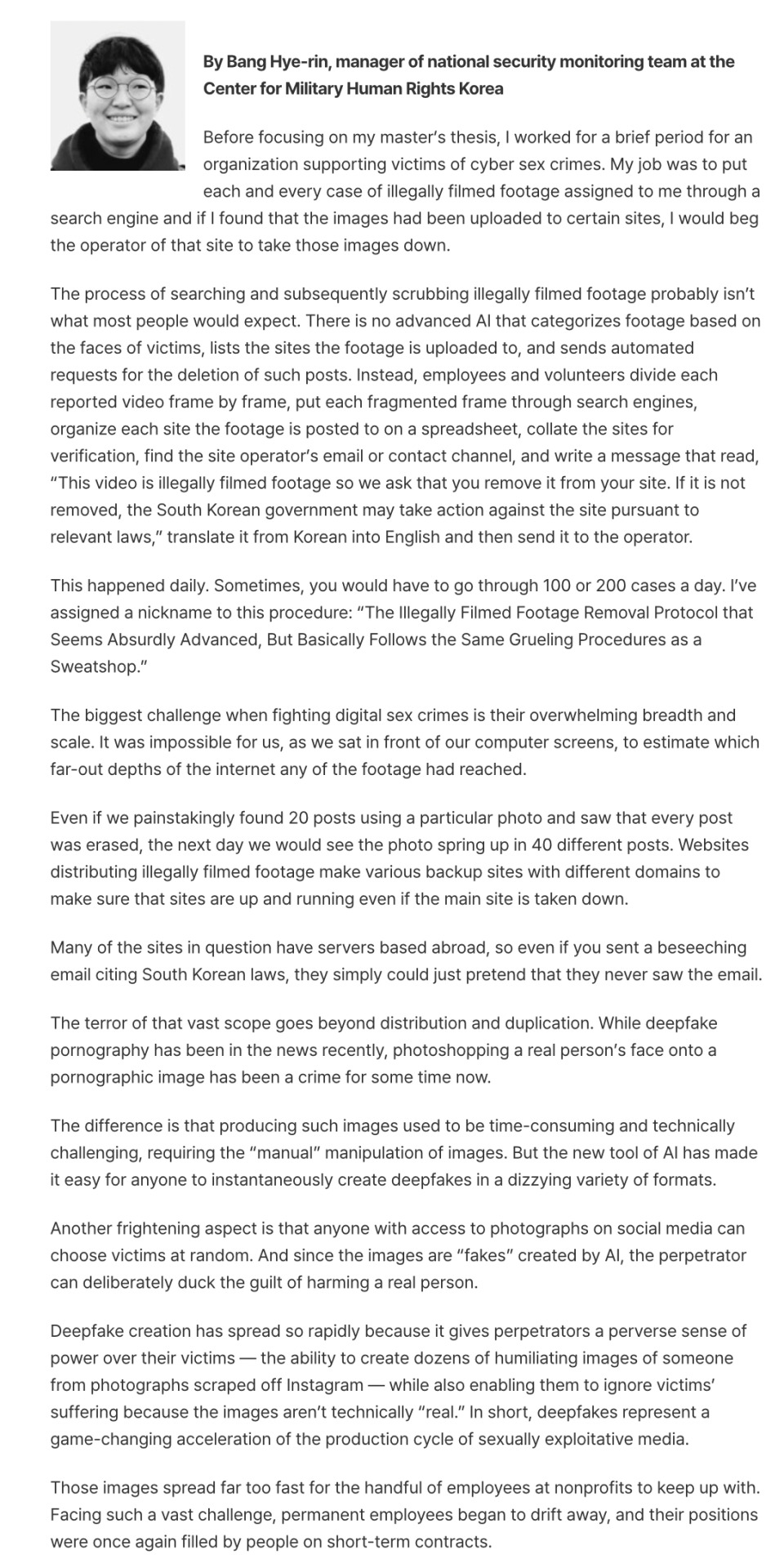
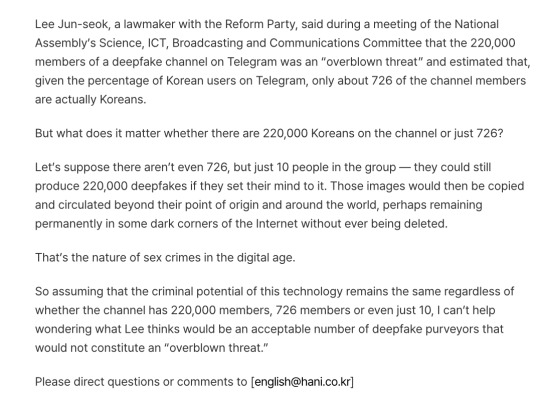
editorial from the english version of the Hankyoreh
archive link
plain text
Before focusing on my master’s thesis, I worked for a brief period for an organization supporting victims of cyber sex crimes. My job was to put each and every case of illegally filmed footage assigned to me through a search engine and if I found that the images had been uploaded to certain sites, I would beg the operator of that site to take those images down.
The process of searching and subsequently scrubbing illegally filmed footage probably isn’t what most people would expect. There is no advanced AI that categorizes footage based on the faces of victims, lists the sites the footage is uploaded to, and sends automated requests for the deletion of such posts. Instead, employees and volunteers divide each reported video frame by frame, put each fragmented frame through search engines, organize each site the footage is posted to on a spreadsheet, collate the sites for verification, find the site operator’s email or contact channel, and write a message that read, “This video is illegally filmed footage so we ask that you remove it from your site. If it is not removed, the South Korean government may take action against the site pursuant to relevant laws,” translate it from Korean into English and then send it to the operator.
This happened daily. Sometimes, you would have to go through 100 or 200 cases a day. I’ve assigned a nickname to this procedure: “The Illegally Filmed Footage Removal Protocol that Seems Absurdly Advanced, But Basically Follows the Same Grueling Procedures as a Sweatshop.”
The biggest challenge when fighting digital sex crimes is their overwhelming breadth and scale. It was impossible for us, as we sat in front of our computer screens, to estimate which far-out depths of the internet any of the footage had reached.
Even if we painstakingly found 20 posts using a particular photo and saw that every post was erased, the next day we would see the photo spring up in 40 different posts. Websites distributing illegally filmed footage make various backup sites with different domains to make sure that sites are up and running even if the main site is taken down.
Many of the sites in question have servers based abroad, so even if you sent a beseeching email citing South Korean laws, they simply could just pretend that they never saw the email.
The terror of that vast scope goes beyond distribution and duplication. While deepfake pornography has been in the news recently, photoshopping a real person’s face onto a pornographic image has been a crime for some time now.
The difference is that producing such images used to be time-consuming and technically challenging, requiring the “manual” manipulation of images. But the new tool of AI has made it easy for anyone to instantaneously create deepfakes in a dizzying variety of formats.
Another frightening aspect is that anyone with access to photographs on social media can choose victims at random. And since the images are “fakes” created by AI, the perpetrator can deliberately duck the guilt of harming a real person.
Deepfake creation has spread so rapidly because it gives perpetrators a perverse sense of power over their victims — the ability to create dozens of humiliating images of someone from photographs scraped off Instagram — while also enabling them to ignore victims’ suffering because the images aren’t technically “real.” In short, deepfakes represent a game-changing acceleration of the production cycle of sexually exploitative media.
Those images spread far too fast for the handful of employees at nonprofits to keep up with. Facing such a vast challenge, permanent employees began to drift away, and their positions were once again filled by people on short-term contracts.
Lee Jun-seok, a lawmaker with the Reform Party, said during a meeting of the National Assembly’s Science, ICT, Broadcasting and Communications Committee that the 220,000 members of a deepfake channel on Telegram was an “overblown threat” and estimated that, given the percentage of Korean users on Telegram, only about 726 of the channel members are actually Koreans.
But what does it matter whether there are 220,000 Koreans on the channel or just 726?
Let’s suppose there aren’t even 726, but just 10 people in the group — they could still produce 220,000 deepfakes if they set their mind to it. Those images would then be copied and circulated beyond their point of origin and around the world, perhaps remaining permanently in some dark corners of the Internet without ever being deleted.
That’s the nature of sex crimes in the digital age.
So assuming that the criminal potential of this technology remains the same regardless of whether the channel has 220,000 members, 726 members or even just 10, I can’t help wondering what Lee thinks would be an acceptable number of deepfake purveyors that would not constitute an “overblown threat.”
38 notes
·
View notes
Text
[W]hat counted as knowledge? [...] [In] British plantation societies from the Chesapeake to the Caribbean [...] [there was a] “process by which authorship is attributed to matters of fact.” [...] Although colonial naturalists drew upon European models and ideas, the plantation societies of the Atlantic were far removed from the [...] [social] world of London gentlemen. [...] [W]hile metropolitan propaganda would seem to preclude the possibility of free and enslaved blacks, Native Americans, women, and even white colonial men as reliable testifiers, in practice European science depended upon such informants. Enslaved and free blacks and Amerindians were seen as both uniquely knowledgeable about the natural world and potentially dangerous as a result of this knowledge. Colonials [white people living in the colony, not living in London/Britain] therefore served as buffer zones ‘‘between the metropolitan place of knowledge ratification and the volatile site of exotic secrets.’’ [...] While colonials acknowledged the authority of their black and indigenous informants as experts about American nature, they represented such expertise as merely the raw materials out of which they fashioned new natural knowledge. [...] Colonial naturalists suggested that it required their verification and experimentation to transform the local expertise of their informants into stable, universal knowledge suitable for European audiences. By translating local knowledge into a universal register, colonials laid claim to the status of authors of new knowledge about American nature. [...]
---
The Maryland physician Richard Brooke was no stranger to the transatlantic circuits of natural history. In 1762, the physician sent the Society of Arts a sample of a tea made from the ‘‘red-root’’ shrub that, he promised, could take the place of Chinese tea while providing additional health benefits. This letter was part of a series of missives that Brooke contributed to metropolitan societies and publications describing New World nature, letters that built his transatlantic reputation as a curious gentleman. [...] Brooke claimed that the tea provided ‘‘wonderful Relief in obstinate Coughs,’’ ‘‘raise[d] the Spirits in vapourish People, and occasion[ed] better rest.’’ The physician reported that he learned of this tea from an unnamed Native American 20 years earlier, but he characterized himself as ‘‘the first and only Person who ever prepared this tea.’’ Personhood, in this case, seemed only to have applied to Europeans or Euro-Americans. By disregarding the personhood of the Native American who first shared the remedy with him, Brooke simultaneously highlighted the indigenous source of his knowledge claim and proclaimed himself as author of it. Asserting the right to name the tea as the ‘‘first’’ person to discover it, Brooke ‘‘has taken the Liberty to call it Mattapany, which is the Indian name of the Place where he was born.’’
He added that if his tea should prove popular with ‘‘the ladies in England,’’ it would give him ‘‘great Pleasure to think that Mattapany will frequently be pronounced by the prettiest lips in the Universe.’’ The term ‘‘Mattapany’’ primarily highlighted Brooke’s personal history, rather than memorializing the Native American who revealed the virtues of the root. [...]
Brooke’s letter regarding Mattapany tea is useful for thinking about authority, authorship, and vernacular knowledge in British plantation societies. Brooke did not deny the indigenous source of the natural knowledge that he reported to the Society of Arts; to the contrary, he highlighted its origins. But while the physician recognized the authority of his unnamed indigenous informant to understand the natural properties of the red-root, he did not represent the Native American as the individual who should be credited for the introduction of this new knowledge claim. Instead, Brooke placed himself in the role of author. He did so by verifying its efficacy, reporting it to the London society, and providing samples of the shrub so that the society’s members could test the tea for themselves. Brooke thereby transformed local American knowledge into a form that his European audience would have seen as acceptable, stable, and even universal. [...]
---
[T]he authority of Amerindians and blacks regarding New World nature was critical to the success of British plantation societies. Colonists relied on the expertise of Amerindians and free and enslaved blacks to tend fields, heal the sick, serve as pathfinders and guides, navigate local waterways, prepare food, and perform a host of other duties that relied on detailed local knowledge about the natural world. Knowledge of the medicinal and culinary properties of local plants, in particular, was a practical necessity. Enslaved Africans adapted their rich heritage of herbalism and healing [...]. The success of plantations relied on the appropriation of both the labor and the specialized agricultural knowledge of enslaved Africans [...]. From the rice field to the sick room, the authority of Amerindians and free and enslaved blacks to speak locally as experts about American nature was reaffirmed daily. [...]
Yet it was quite another thing to be represented as the author of new scientific knowledge before a European audience. [...] Rather than being antiauthors who left almost no trace in published accounts, black and indigenous informants’ presence in colonials’ publications and correspondence lent epistemological authority to their texts. As Parrish has argued, some claims even required indigenous or African origins in order for them to be credible. That colonial naturalists relied on a person of Amerindian or African descent is made clear in their various texts, yet the identity of the particular informant was rarely provided. [...] Historians of science have noted the importance of identity for establishing the credibility of claims in early modern natural philosophy. The Royal Society, for example, included the names of the gentlemen who witnessed an experiment, trusting that the credibility of the individual gentlemen would translate into credibility for the experiment [...]. Slaves and Indians did not, therefore, appear in naturalists’ texts as fellow claimants or as independent authors of new knowledge. Rather, they appeared as necessary components of white naturalists’ credibility - in essence, instruments of their knowledge creation. [...]
Colonials positioned themselves as not merely the brokers or go-betweens of American natural knowledge, but as alchemists of sorts, turning the base materials of local knowledge into something more precious.
---
All text above by: Kathleen S. Murphy. “Translating the vernacular: Indigenous and African knowledge in the eighteenth-century British Atlantic.” Atlantic Studies Volume 8, Issue 1, pages 29-48. March 2011. DOI at: doi dot org/10.1080/14788810.2011.541188 [Bold emphasis and some paragraph breaks/contractions added by me. Presented here for commentary, teaching, criticism purposes.]
149 notes
·
View notes
Note
HoI ✨ I love your art and your style, keep up the good work! ^^ As for the ask: I know that key to getting better at art is practice. But practice what? What did you do as a begginer artist?
When I was a kid, before the internet was popular, I bought many drawing instruction books. I followed the instructions in the book to practice.
"Practice for what?" It is based on which theme would you like to improve? Such as characters, scenes, composition..etc
I recommend continuing to scroll to learn more about how to practice.
Oh boy, allow me to share the FB post about practice . Although it's Chinese, I will put an English translation over here
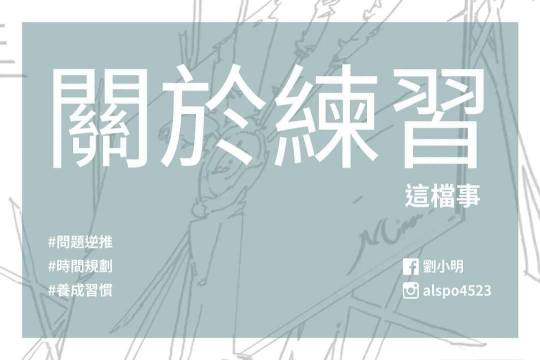
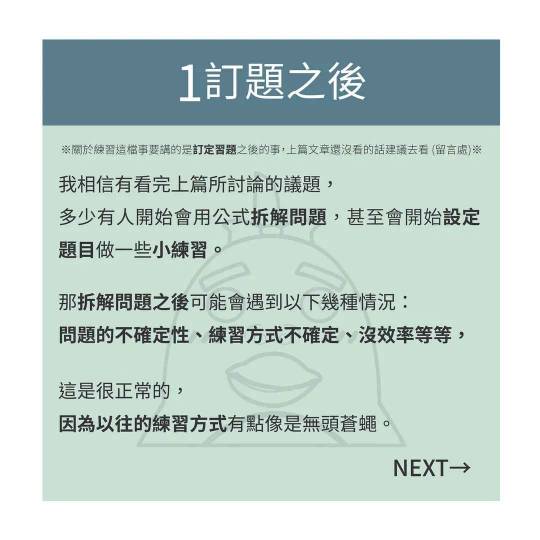
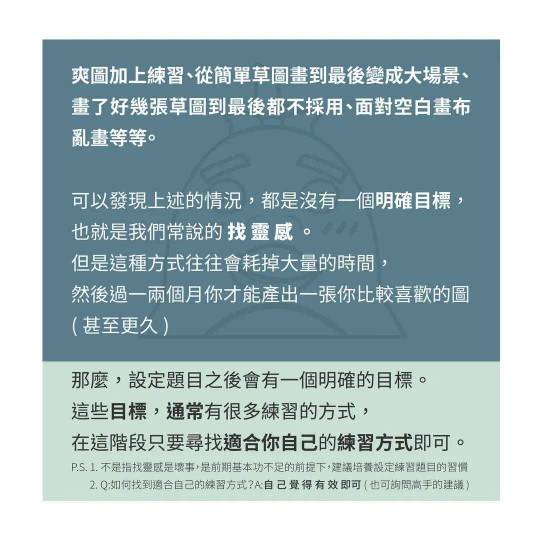
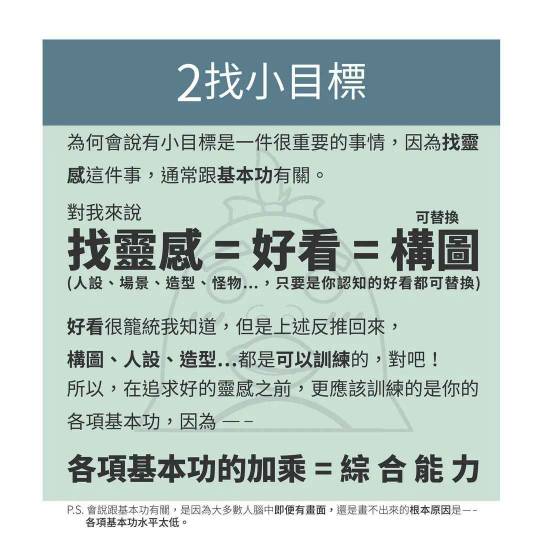

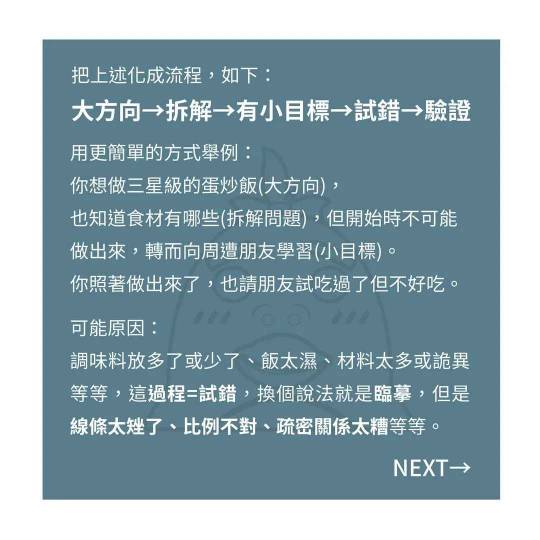
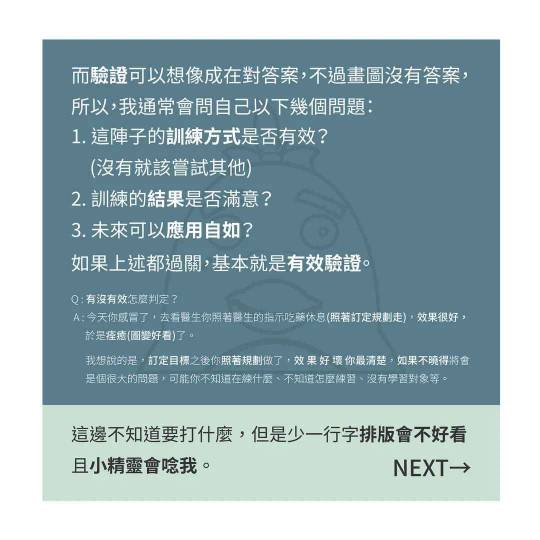
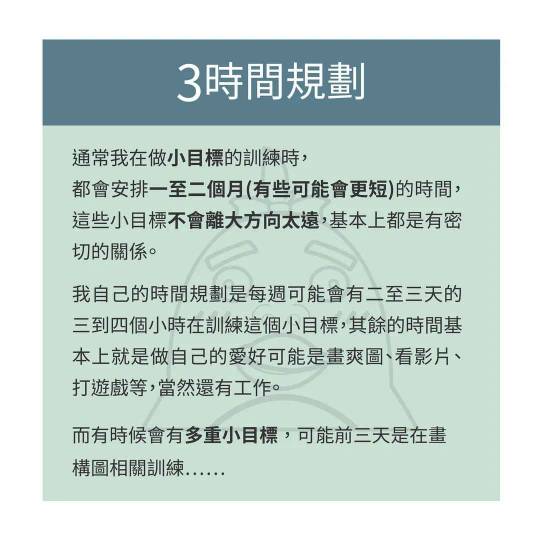
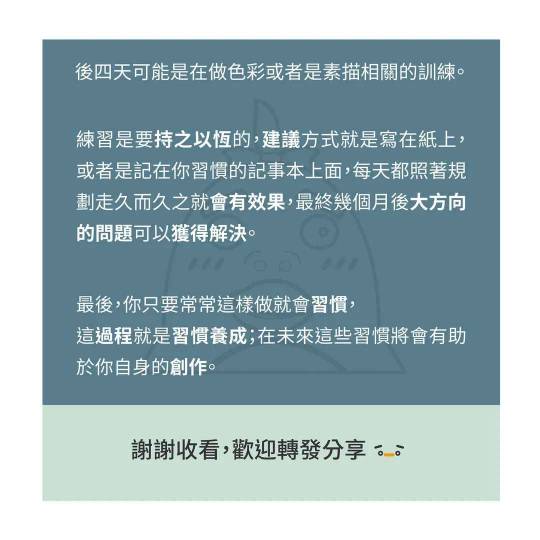
English translation
Page 1:
"About Practice"
#Problem Solving #Time Management #Habit Formation
Page 2:
1. After Setting the Question
The important thing to talk about here is what happens after setting the question. If you haven't seen the previous article, you might want to check it out first.
I believe after reading the discussion in the previous article, some people might start using official solutions to tackle the problems or even begin setting some questions for practice.
After solving the problem, you might encounter the following situations:
Uncertainty about the problem,
Uncertainty about the practice method,
Lack of efficiency, etc.
This is quite normal because the previous practice methods might have been a bit aimless.
Page 3:
When you continue to practice drawing, you might find that the drawing starts simple but eventually evolves into a larger scene. After drawing several sketches, you might end up not using them or facing a blank canvas, feeling lost.
You might realize that all these scenarios lack a clear goal, which is what we often refer to as finding a sense of direction. But this kind of practice often consumes a lot of time, and it might take a month or two before you can create a drawing that you are more satisfied with (or even longer).
Therefore, after setting a question, having a clear goal is crucial. This goal usually involves many practice methods. During this period, you need to find a method that suits you for practicing.
P.S. This doesn't mean you need to find direction immediately; if your basic skills are lacking, it's recommended to focus on building basic skills first.
Page 4:
2. Finding Small Goals
Why is having small goals so important? Because finding direction usually relates to basic skills.
For me, finding direction = creating something visually appealing = constructing a good composition (for example: character design, scene setting, modeling, creatures, etc., as long as you recognize it as visually appealing).
Creating something visually appealing is something I understand well, but based on the reverse deduction, composition, character design, modeling, etc., can all be practiced, right? Therefore, before seeking to create something visually appealing, you should first practice your basic skills because –
The sum of all basic skills = comprehensive ability.
Page 5:
So, the stronger your comprehensive ability, the more you can express the desired visual appeal in your drawings. After enhancing your comprehensive ability, you can create a work with a certain level of quality, even if you haven't found your direction yet.
Speaking of composition, character design… aren't these big-picture problems? Right? Then can't they be broken down? After breaking them down, there will be small goals. Below is my thought process:
Recently, I need to do more training in modeling (big picture), but how should I train the model? Should I focus on proportions? Structure? Shadows? Concept? Etc. (small goals). Since there are so many small goals, let's pick one, and each training session will focus on one aspect! (Trial and Error).
Page 6:
This forms the process flow as follows:
Big Picture -> Break Down -> Small Goals -> Trial and Error -> Verification
Using a simpler example:
You want to make a three-star fried rice dish (big picture), you know what ingredients are needed (break down the problem), but you might not be able to make it right away, so you turn to friends and learn (small goals).
You try making it, but when your friends taste it, it doesn't turn out well.
Possible reasons:
The seasoning was too much or too little,
The rice was too wet,
The ingredients didn’t mix well, etc.
This process = trial and error. In other words, it’s the process of refining, but the line was too thick, the proportions were off, the details were too cluttered, etc.
Page 7:
Verification can be imagined as having the correct answer, but drawing doesn't have a fixed answer, so I usually ask myself the following questions:
Was this method of practice effective? (If not, then try something else)
Am I satisfied with the results of the practice?
Can I apply this in the future as needed?
If all the above are true, then it's essentially a valid verification.
Q: How do you determine if it's effective? A: Like following a doctor's prescription (following a plan), if the results are good, then it's effective (illness cured).
My idea is that after setting a goal, if you follow the plan and the effect is good, it's fine. If the result is bad, then there might be a problem with the plan. You might still be practicing, not knowing what you are missing, and not having enough experience.
Page 8:
3. Time Management
Usually, when I practice small goals, I schedule one to two months (some might be shorter) for this training.
16 notes
·
View notes
Text
A very interesting editorial by the journalist, political analyst and activist Vicent Partal. I've translated it to English for more people to understand:
The psychological impact of historical violence against Catalans
The time has come to consider the reparation of the historical violence committed by Spain against the Catalans. Because it's a mark that we carry every day and that defines our society and the behaviour of our oppressors.
I started Sant Jordi celebrations on Saturday going to Via Laietana [Spanish military police headquarters in Barcelona -capital city of Catalonia- famous for being the place where the police have tortured many people in brutal ways] to listen to some of the witnesses of the book Tortured. Via Laietana 43. Twenty-two women witnesses of terror (1941-2019) by Gemma Pasqual. They explained, with an exemplary bravery and dignity, how they had suffered in that horror house -under the dictatorship and the democracy. Since 1940 until nowadays. The attendees cut the street, we were carrying banners condemning torture and the torturers as we listened for half an hour to those women's narrations about what they had been through right there, behind those doors, one by one.
It was precisely in one of the most intimate and chilling moments when a man who was walking behind us, precisely through the door of Via Laietana 43 [the police headquarters], dared to shout insults to the protesters, and continued walking in front of the policemen stationed there. It's evident that he did not feel any respect nor interest for those women's experiences, and I assume that he didn't care about everything they went through, all the opposite. But behind his action there was the security and the arrogance of knowing that he would face no consequence. All the opposite: that, if someone tried to get back to him, he had the police there to protect him.
This verification reminded me of a book I read recently with a lot of interest: Caste, The Origins of Our Discontents, by the journalist Isabel Wilkerson. The book has had a great impact in the United States of America but also in countries like India, because Wilkerson explains how and why racism works not only in the USA, but also in more places -in the case of India, it talks about the dalit caste. And in what it explains there's a few lessons -because after all, she's talking about oppression and resistance- that are perfectly applicable to the Catalan case.
I'll start with this very Spanish man who insulted us on Saturday. How can there be someone so insensitive?, many of us asked ourselves after seeing his attitude. And Wilkerson's answer is clarifying: "The only way of keeping a group of intelligent people artificially oppressed, below others and below their own talent, is with violence and terror, psychological and physical, applied with the intention of stopping them from resisting it, even before they can imagine that they could resist to it." And she explains that this terror, that this violence, is not spontaneous at all, but is fabricated by the oppressors throughout history and they pass it down from generation to generation. She says: "Dehumanizing another human being is not only declaring that he's not human, and it doesn't happen by chance one day. In order to dehumanize a human collective, a very long process, a methodic programmation, is needed. It needs a lot of energy and effort, it needs resources, to accomplish such an antinatural thing as denying that another member of your species is your equal and, thus, denying that he has the same rights."
And with a quote by the sociologist Guy B. Johnson she explains that accumulated historical violence is the key to this oppression process: "To understand the conflict, you must understand that during the years of slavery white people got used to the idea that they could 'regulate' black people's insolence and insubordination through force, without consent and with the support of the law and the state apparatus." Exactly the same as here. And it's as simple as this: for the last 300 years, but very specially during the years of the Francoist dictatorship [1939-1978], Spanish people -particularly Spanish people who live in Catalonia- have gotten used to the fact that Catalan people's "insolence and insubordination" can be regulated through the use of violence and with the explicit support of a law that always is and always will be discriminatory against Catalans and favourable to them, Spaniards.
The security given by decades where this always happens like this, systematically, explains the arrogance and shamelessness with which a passerby is able to walk in front of a group of women explaining that they were tortured right there, in the building in front of them, and, even seeing they're accompanied by hundreds of people, he allows himself to confront them all, him alone, with an insulting shout. Simply, he's psychologically convinced that those insolents and insubordinates will be put in their place by the state's violence, as, in fact -and this is the maximum gravity of what happened in 2017-, the Spanish state did on October 1st [the Catalonia independence referendum, when the Spanish government sent the military police to beat up voters, kidnap votes, and close the voting places to avoid the referendum from taking place] and after the declaration of independence. If today we have the Spanish nationalists encouraged -and autonomists scared- it's because the Pavlov works. We have been beaten again.
In Isabel Wilkerson's book, a calculation catches the reader's attention. She asks in what year will the citizens of the USA have spent as much time having slaves than not having them. And the answer is 2111. In 2111, for the first time, African Americans will have spent as long in freedom -at least theoretically- than the amount of time they spent -and which weights on everyone's consciences, black or white- being slaves. In 2111 maybe African Americans will no longer feel the historical weight that they feel now and maybe -we'll see about that- white people will have gotten used to the fact that they're equal humans, with the same rights. By highlighting this number, Wilkerson explains to what point the past's weight is expressed nowadays and the importance of taking it into account. The way in which it's particularly important among oppressors, who continue thinking that they can do whatever they want with us -and that they have the right to it- and they are not afraid at all, because experience has proven that if someone gets hit, if someone gets arrested, if someone gets jailed, if someone gets exiled, if someone gets tortured, it will be us and not them.
The book has made me reflect and has impressed me a lot because of how it approaches such a deep psychological component of the relation between oppression and freedom. (...)
I'll continue with the example of Via Laietana. The torture witnesses in Gemma Pasqual's book range from 1940, when the Francoist troops had just entered Barcelona, to 2019, during the protests against the Supreme Court's sentence [jail sentence for Catalan civil society leaders, NGO members and democratically-elected politicians for insubordination to the Spanish government because of their involvement in Catalonia's independence movement]. That's 79 years. Assuming that from now on they won't torture again, until the year 2102 Catalans, and particularly those from Barcelona, will have lived as long without being threatened with torture and violence in the Via Laietana headquarters as they have lived used to -and scared of- this torture and violence. And do you think this doesn't matter? That it doesn't leave a mark? That it doesn't condition our behaviour and, above everything else, our oppressors' behaviour?
#actualitat#catalunya#països catalans#human rights#anti torture#spain#minorities#minority rights#current events#social justice#catalonia#coses de la terra
59 notes
·
View notes
Text
Thailand SMART Visa
1.1 Statutory Foundations
Established under Royal Decree on SMART Visa B.E. 2561 (2018)
Amended by Ministerial Regulation No. 377 (2021) expanding eligible sectors
Operates within Thailand 4.0 Economic Model under BOI oversight
1.2 Governance Structure
Primary Authority: Board of Investment (BOI)
Interagency Coordination:
Immigration Bureau (visa issuance)
Digital Economy Promotion Agency (tech qualifications)
Ministry of Higher Education (academic validation)
Technical Review Committees:
12 sector-specific panels
Investment verification unit
2. Eligibility Criteria & Qualification Pathways
2.1 SMART-T (Experts)
Compensation Thresholds
Base Salary: Minimum THB 200,000/month (USD 5,800)
Alternative Compensation:
Equity valued at 25% premium
Performance bonuses (capped at 40% of base)
2.2 SMART-E (Entrepreneurs)
Startup Metrics
Revenue Test: THB 10M+ ARR
Traction Test: 50,000 MAU
Funding Test: Series A (THB 25M+)
Accelerator Requirements:
DEPA-certified programs
Minimum 6-month incubation
3. Application Process & Technical Review
3.1 Document Authentication Protocol
Educational Credentials:
WES/IQAS evaluation for foreign degrees
Notarized Thai translations (MFA-certified)
Employment Verification:
Social security cross-check
Three professional references
3.2 Biometric Enrollment
Facial Recognition: 12-point capture system
Fingerprinting: 10-print electronic submission
Iris Scanning: Optional for Diamond tier
4. Privilege Structure & Compliance
4.1 Employment Rights Framework
Permitted Activities:
Primary employment (≥80% time)
Academic collaboration (≤20%)
Advisory roles (max 2 concurrent)
Restrictions:
Local employment outside specialty
Political activities
Unapproved commercial research
4.2 Dependent Provisions
Spousal Work Rights:
General employment permitted
No industry restrictions
Child Education:
25% tuition subsidy
University admission priority
4.3 Mobility Features
Airport Processing:
Dedicated SMART lanes at 6 airports
15-minute clearance guarantee
Re-entry Flexibility:
Unlimited exits
72-hour grace period
5. Sector-Specific Implementations
5.1 Biotechnology
Special Privileges:
Lab equipment duty waivers
Fast-track FDA approval
50% R&D tax deduction
5.2 Advanced Manufacturing
Incentives:
Robotics import tax exemption
Industrial land lease discounts
THB 500K training subsidy
5.3 Digital Infrastructure
Cloud Computing:
VAT exemption on services
30% energy cost reduction
Cybersecurity:
Liability protections
Gov't certification fast-track
6. Compliance & Monitoring
6.1 Continuous Reporting
Quarterly:
Employment verification
Investment maintenance
Annual:
Contribution assessment
Salary benchmarking
6.2 Renewal Process
Documentation:
Updated financials
Health insurance (USD 100K)
Performance metrics
Fees:
THB 10,000 renewal
THB 1,900 visa stamp
7. Emerging Developments
71 2024 Enhancements
Blockchain Specialist Category
Climate Tech Fast-Track
EEC Regional Expansion
7.2 Pending Reforms
Dual Intent Provision
Skills Transfer Mandate
Global Talent Pool
8. Strategic Application Approach
8.1 Pre-Submission Optimization
Compensation Restructuring
Patent Portfolio Development
Professional Endorsements
8.2 Post-Approval Planning
Tax Residence Strategy
Asset Protection
Succession Planning
9. Risk Management
9.1 Common Rejection Reasons
Document Issues (32%)
Qualification Gaps (28%)
Financial Irregularities (19%)
9.2 Operational Challenges
Banking Restrictions
Healthcare Access
Cultural Integration
#thailand#immigration#thai#thaiimmigration#thaivisa#visa#immigrationlawyers#immigrationinthailand#thailandsmartvisa#smartvisa#smartvisainthailand#thaismartvisa
2 notes
·
View notes
Text
Immigration Services in Thailand
1.1 Statutory Foundations
Immigration Act B.E. 2522 (1979): Primary legislation
Ministerial Regulations: 47 implementing regulations (updated 2023)
Royal Decrees: Special provisions for investment/retirement
1.2 Organizational Structure
Immigration Bureau: Under Royal Thai Police
Headquarters (Chaeng Wattana, Bangkok)
76 Provincial Offices
32 Border Checkpoints
Specialized Units:
Visa Division (Section 1)
Extension Division (Section 2)
Investigation Division (Section 3)
2. Core Visa Categories and Processing
2.2 Special Visa Programs
SMART Visa: 4-year stay for experts/investors
LTR Visa: 10-year privilege visa
Elite Visa: 5-20 year membership program
3. Application Procedures
3.1 Document Authentication
Notarization Requirements:
Home country documents
Thai Ministry of Foreign Affairs legalization
Translation Standards:
Certified translators
Embassy verification
4. Digital Transformation Initiatives
4.1 Online Systems
e-Extension: Pilot program for 12 visa types
90-Day Reporting: Online portal and mobile app
TM30 Automation: Hotel API integration
4.2 Biometric Implementation
Facial Recognition: At 6 major airports
Fingerprint Database: 10-print system since 2018
Iris Scanning: Testing at Suvarnabhumi
5. Compliance and Enforcement
5.1 Monitoring Systems
Overstay Tracking: Real-time alerts after 7 days
Visa Run Detection: Algorithmic pattern analysis
Work Permit Integration: MOE-Immigration data sharing
6. Provincial Variations
6.2 Special Economic Zones
Eastern Economic Corridor: Fast-track processing
Border Provinces: Cross-border worker programs
7. Specialized Services
7.1 Corporate Immigration
BOI Fast Track: 7-day work permit processing
Regional HQ Packages: Multiple-entry privileges
Startup Visa: DEPA-endorsed companies
7.2 Family Reunification
Dependent Visas: Spouse/children under 20
Parent Visas: Financial guarantee requirements
Thai National Sponsorship: Income thresholds
8. Emerging Trends (2024 Update)
8.1 Policy Developments
Digital Nomad Visa: Expected Q4 2024
Airport Automated Clearance: Expansion to 8 more nationalities
Visa Fee Restructuring: Proposed 15-20% increase
8.2 Technological Advancements
Blockchain Verification: For document authentication
AI-Assisted Processing: Risk assessment algorithms
Mobile Biometrics: Pilot for frequent travelers
9. Strategic Considerations
9.1 Application Optimization
Document Preparation:
6-month bank statement continuity
Property lease registration
Timing Strategies:
Avoid holiday periods
Pre-submission checks
9.2 Compliance Management
Record Keeping:
Entry/exit stamps
TM30 receipts
Advisory Services:
Licensed lawyers vs agents
BOI-certified consultants
#thailand#immigration#immigrationlawyers#visa#visainthailand#immigrationinthailand#immigrationlawyersinthailand#thai#thaivisa#immigrationservices
2 notes
·
View notes
Text
Child Adoption in Thailand
1.1 Primary Legislation
Adoption Act B.E. 2522 (1979): Core legal framework
Child Protection Act B.E. 2546 (2003): Safeguards for adopted children
International Private Law Act B.E. 2541 (1998): Cross-border adoptions
1.2 Regulatory Bodies
Department of Children and Youth (DCY): Central oversight
Child Adoption Center of Thailand: Primary processing agency
Juvenile and Family Courts: Legal approval authority
Ministry of Social Development and Human Security: Policy formulation
2. Eligibility Criteria for Prospective Parents
2.1 Basic Qualifications
Age Requirements:
Minimum 25 years old
At least 15 years older than child
Maximum 45-year age gap (exceptions possible)
Marital Status:
Married couples (heterosexual only)
Single applicants (gender-specific restrictions apply)
Financial Capacity:
Minimum THB 150,000/month income
Stable employment history (3+ years)
2.2 Health and Background Checks
Medical Examination:
Complete physical including HIV test
Psychological evaluation
Criminal Clearance:
Thai police records
Home country Interpol check
Child abuse registry verification
3. Adoption Categories and Processes
3.2 International Adoption Protocol
Hague Convention Compliance:
Thailand is not signatory but follows principles
Requires home study by accredited agency
Document Legalization:
Notarization
Ministry of Foreign Affairs authentication
Thai embassy legalization
4. Child Eligibility and Matching
4.1 Adoptable Children Profile
Age Distribution:
70% under 5 years
25% 6-12 years
5% teenagers
Special Needs Considerations:
Medical conditions (30% of cases)
Sibling groups (15%)
4.2 Matching Criteria
Cultural Compatibility: Religion, language
Family Environment: Urban/rural preferences
Child's Background: Trauma history assessment
5. Legal Procedures and Timelines
5.1 Pre-Adoption Process
Application Submission (DCY Form 1)
Home Study (3-6 months)
5+ visits by social worker
Family environment assessment
Approval Committee Review (2-3 months)
5.2 Court Procedures
Filing Petition: Juvenile Court jurisdiction
Hearings:
Initial review (30 days post-filing)
Child interview (closed session)
Final ruling (typically 60-90 days)
Post-Adoption Reports:
Quarterly for first year
Biannually until child is 18
6. Post-Adoption Legal Framework
6.1 Parental Rights and Obligations
Full Legal Parentage: Birth certificate amendment
Inheritance Rights: Equal to biological children
Revocation Conditions: Extreme neglect/abuse
6.2 Citizenship Issues
Thai Children:
Retain citizenship if adopted internationally
Dual citizenship permitted
Foreign Adopters:
No automatic Thai citizenship for child
Visa sponsorship requirements
7. Special Case Adoptions
7.1 Special Needs Children
Expedited Process: 6-9 months
Additional Support:
Medical subsidy (THB 50,000/year)
Therapy access
7.2 Older Child Adoption
Consent Requirement: Child's agreement (age 12+)
Transition Programs: 3-month integration period
8. Emerging Trends and Challenges
89.1 Digital Transformation
e-Adoption Portal: Pilot phase for document submission
Blockchain Verification: For international documents
8.2 Policy Developments
Proposed Amendments:
Single male adopter restrictions
Extended post-adoption monitoring
COVID-19 Impact:
40% reduction in international adoptions
Virtual home study trials
9. Strategic Considerations
9.1 Document Preparation
Timeline Optimization:
Medical exams (6-month validity)
Police clearance (3-month validity)
Translation Requirements:
Certified Thai translations
MFA authentication
9.2 Legal Representation
Court Procedures:
Required for international cases
Recommended for contested adoptions
Appeal Process:
30-day window
Supreme Court jurisdiction
#thailand#familylaw#family#thaifamily#thailandfamilylaw#childadoption#childadoptioninthailand#thailandchildadoption
2 notes
·
View notes
Text
Back Translation Services and Using a Back Translation Company
The Art and Science of Back Translation Services Translation is the process of converting text from one language to another. This practice ensures that information is accessible and comprehensible to people who speak different languages. Among the various methods of translation, back translation stands out as a particularly rigorous and insightful technique. The Importance of…

View On WordPress
#academic back translation services#accurate back translation#back translation company#back translation expertise#back translation services#Back-translation process#business back translation services#corporate back translation services#cultural translation accuracy#experienced back translators#high-quality back translation#international back translation#legal back translation services#linguistic back translation#literary back translation#medical back translation services#multilingual back translation#professional back translation#reliable back translation#scientific back translation services#specialized back translation services#translation accuracy#translation comparison#translation consistency#translation discrepancy resolution#translation fidelity#translation quality control#translation verification#TV and film back translation
0 notes
Text
Thailand SMART Visa
1.1 Statutory Foundations
Established under Royal Decree on SMART Visa B.E. 2561 (2018)
Amended by Ministerial Regulation No. 377 (2021) expanding eligible sectors
Operates within Thailand 4.0 Economic Model under BOI oversight
1.2 Governance Structure
Primary Authority: Board of Investment (BOI)
Interagency Coordination:
Immigration Bureau (visa issuance)
Digital Economy Promotion Agency (DEPA) for tech qualifications
Ministry of Higher Education for academic validation
Technical Review Committees:
Sector-specific panels (12 industries)
Investment verification unit
2. Eligibility Criteria & Qualification Pathways
2.1 SMART-T (Experts)
Compensation Thresholds
Base Salary: Minimum THB 200,000/month (USD 5,800)
Alternative Compensation:
Equity valued at 25% premium to cash salary
Performance bonuses (capped at 40% of base)
2.2 SMART-E (Entrepreneurs)
Startup Metrics
Revenue Test: THB 10M+ ARR
Traction Test: 50,000 MAU
Funding Test: Series A (THB 25M+)
Accelerator Requirements:
DEPA-certified programs
Minimum 6-month incubation
3. Application Process & Technical Review
3.1 Document Authentication Protocol
Educational Credentials:
WES/IQAS evaluation for foreign degrees
Notarized Thai translations (certified by MFA)
Employment Verification:
Social security cross-check (home country)
Three professional references (direct supervisors)
3.2 Biometric Enrollment
Facial Recognition: 12-point capture system
Fingerprinting: 10-print electronic submission
Iris Scanning: Optional for Diamond tier
4. Privilege Structure & Compliance
4.1 Employment Rights Framework
Permitted Activities:
Primary employment with sponsor (≥80% time)
Academic collaboration (≤20% time)
Advisory roles (max 2 concurrent)
Restrictions:
Local employment outside specialty
Political activities
Unapproved commercial research
4.2 Dependent Provisions
Spousal Work Rights:
General employment permitted
No industry restrictions
Child Education:
25% tuition subsidy at partner schools
University admission priority
4.3 Mobility Features
Airport Processing:
Dedicated SMART lanes at 6 airports
15-minute clearance guarantee
Re-entry Flexibility:
Unlimited exits
72-hour grace period
5. Sector-Specific Implementations
5.1 Biotechnology
Special Privileges:
Lab equipment duty waivers
Fast-track FDA approval
50% R&D tax deduction
5.2 Advanced Manufacturing
Incentives:
Robotics import tax exemption
Industrial land lease discounts
THB 500K training subsidy
5.3 Digital Infrastructure
Cloud Computing:
VAT exemption on services
30% energy cost reduction
Cybersecurity:
Liability protections
Gov't certification fast-track
6. Compliance & Monitoring
6.1 Continuous Reporting
Quarterly:
Employment verification
Investment maintenance
Annual:
Contribution assessment
Salary benchmarking
6.2 Renewal Process
Documentation:
Updated financials
Health insurance (USD 100K)
Performance metrics
Fees:
THB 10,000 renewal
THB 1,900 visa stamp
7. Emerging Developments
7.1 2024 Enhancements
Blockchain Specialist Category
Climate Tech Fast-Track
EEC Regional Expansion
7.2 Pending Reforms
Dual Intent Provision
Skills Transfer Mandate
Global Talent Pool
8. Strategic Application Approach
8.1 Pre-Submission Optimization
Compensation Restructuring
Patent Portfolio Development
Professional Endorsements
8.2 Post-Approval Planning
Tax Residence Strategy
Asset Protection
Succession Planning
9. Risk Management
9.1 Common Rejection Reasons
Document Issues (32%)
Qualification Gaps (28%)
Financial Irregularities (19%)
9.2 Operational Challenges
Banking Restrictions
Healthcare Access
Cultural Integration
#thailand#immigration#visa#immigrationinthailand#immigrationlawyers#thai#thaivisa#immigrationlawyersinthailand#thailandsmartvisa#smartvisa#smartvisainthailand#thaismartvisa
2 notes
·
View notes
Text
1. Structural Foundations of the SMART Visa Program
1.1 Legislative Architecture
The SMART Visa operates under:
Royal Decree on SMART Visa B.E. 2561 (2018)
Thailand 4.0 Economic Policy Framework
BOI Investment Promotion Act (No. 4) B.E. 2560
1.2 Interagency Governance
Primary Authority: Board of Investment (BOI)
Implementation Partners:
Immigration Bureau (visa issuance)
Ministry of Digital Economy and Society (tech qualifications)
Ministry of Higher Education (academic validation)
2. Category-Specific Qualification Matrix
2.1 SMART-T (Specialists)
Technical Thresholds:
Salary Floor: THB 200,000/month (USD 5,800)
Experience Validation:
5+ years in qualifying field
Patent holders given priority
PhD waivers for certain disciplines
Industry Prioritization:
Biotechnology (Gene Therapy, Precision Medicine)
Advanced Manufacturing (Robotics, 3D Printing)
Digital Infrastructure (AI, Quantum Computing)
2.2 SMART-I (Investors)
Due Diligence Process:
Phase 1: BOI business plan review (45 days)
Phase 2: Anti-money laundering clearance
Phase 3: Investment tracing audit
2.3 SMART-E (Entrepreneurs)
Startup Validation Framework:
Tier 1 Incubators: DEPA, Thai Venture Capital Association
Minimum Traction Metrics:
THB 10M ARR or
50,000 MAU or
Series A funding
Capital Requirements:
Bootstrapped: THB 600,000 liquid
Funded: Minimum THB 5M valuation
3. Advanced Application Mechanics
3.1 Document Authentication Protocol
Educational Credentials:
WES or IQAS evaluation for non-Thai degrees
Notarized Thai translations
Employment History:
Social security cross-verification
Reference checks with former employers
3.2 Technical Review Process
Stage 1: Automated system screening
Stage 2: BOO specialist committee review
Stage 3: Final approval by Deputy Secretary-General
4. Privilege Structure and Limitations
4.1 Work Authorization Scope
Permitted Activities:
Primary employment with sponsor
Consulting (max 20% time allocation)
Academic collaboration
Prohibited Activities:
Local employment outside specialty
Unapproved commercial research
Political activities
4.2 Dependent Provisions
Spousal Work Rights:
General employment permitted
No industry restrictions
Child Education:
International school subsidies
University admission preferences
4.3 Mobility Advantages
Fast-Track Immigration:
Dedicated SMART lanes at 6 major airports
15-minute clearance guarantee
Re-entry Flexibility:
Unlimited exits without visa voidance
Automatic 48-hour grace period
5. Compliance and Renewal Dynamics
5.1 Continuous Eligibility Monitoring
Quarterly Reporting:
Employment verification
Investment maintenance
Research output (for academics)
Annual Review:
Salary benchmark adjustment
Contribution assessment
5.2 Renewal Process
Documentation Refresh: Updated financials, health insurance
Performance Evaluation: Economic impact assessment
Fee Structure: THB 10,000 renewal fee + THB 1,900 visa stamp
5.3 Grounds for Revocation
Material Changes: Employment termination, investment withdrawal
Compliance Failures: Missed reporting, legal violations
National Security Concerns: Classified determinations
6. Comparative Analysis with Global Competitors
6.1 Strategic Advantages
Tax Optimization: 17% flat rate option
Research Incentives: BOO matching grants
Commercialization Support: THBI co-investment
7. Emerging Policy Developments
7.1 2024 Program Enhancements
Blockchain Specialist Category (Q3 rollout)
Climate Tech Fast-Track (Carbon credit linkage)
Regional Expansion: Eastern Economic Corridor focus
7.2 Pending Legislative Changes
Dual Intent Provision: PR application without visa surrender
Skills Transfer Mandate: Local training requirements
Global Talent Pool: Reciprocal agreements in negotiation
8. Practical Application Strategies
8.1 Pre-Application Optimization
Salary Structuring: Base vs variable compensation
Patent Portfolio Development: Thai IP registration
Local Network Building: Thai professional associations
8.2 Post-Approval Planning
Tax Residence Strategy: 180-day calculations
Asset Protection: Thai holding company formation
Succession Planning: Will registration requirements
9. Critical Risk Factors
9.1 Common Rejection Reasons
Document Discrepancies: Date inconsistencies
Qualification Gaps: Unrecognized certifications
Financial Irregularities: Unverified income streams
9.2 Operational Challenges
Banking Restrictions: Foreign account limitations
Healthcare Access: Specialty treatment approvals
Cultural Integration: Workplace adaptation
10. Conclusion: Strategic Implementation Framework
For optimal SMART Visa utilization:
Pre-qualification Audit: 90-day preparation period
BOI Engagement: Pre-submission consultation
Compliance Infrastructure: Digital reporting systems
Contingency Planning: Alternative category eligibility
#thailand#immigration#immigrationinthailand#thailandvisa#thaivisa#visa#thai#thailandsmartvisa#smartvisa#smartvisainthailand#thaismartvisa
2 notes
·
View notes
Text
💍 Getting Married in a Russian Prison: My Experience at IKU-5 (Vologda Pyatak) 💍
Ever wondered what it’s like to get married inside a Russian prison? Well, let me take you through the fascinating (and slightly bureaucratic) journey of planning my wedding at IKU-5, also known as Vologda Pyatak, one of Russia’s strictest penal colonies. Spoiler alert: It’s not your typical fairytale, but it’s filled with just as much love, commitment, and resilience!
1. The Legal Rollercoaster: Paperwork, Approvals, and More Paperwork
Before anything romantic can happen, there’s an avalanche of legal procedures to tackle. Here’s how it goes down:
📄 Application Process:
Everything starts with an official marriage application to the Belozersky Registry Office (ZAGS), the authority that oversees marriages in the region.
My checklist? Personal ID, proof of single status (because apparently “trust me, I’m not married” doesn’t cut it), and a translated stack of documents since I’m a foreign national.
🔍 Prison Approval:
Since we're getting married inside a high-security facility, the prison administration has to give the green light. Think of it as a background check… but for love.
🗣️ The Translator Clause:
If you’re not fluent in Russian (or legal jargon), a certified translator is a must. They ensure you fully understand the vows, so there are no accidental “I dos” to anything unexpected!
2. Setting the Date: Timing is Everything
Once the paperwork mountain is conquered, we get an official wedding date. The ceremony takes place inside the prison, usually in a designated meeting area under strict security measures. And trust me, no venue booking apps are involved here—just patience and persistence.
In IKU-5, everything is formal, brief, and structured. Think of it as a wedding with military precision.
3. The Big Day: Security, Vows, and a Little Romance
The wedding day itself is… an experience. Here’s what to expect:
🔐 Security Checks Galore:
Before stepping inside, I had to go through an intense security screening—ID verification, personal item checks, and a stern “no funny business” vibe.
💒 The Ceremony:
A simple room, a few officials, and my love standing there. The ZAGS representative leads us through the ceremony, ensuring everything is legally binding.
Cue the translator to make sure no promises are lost in translation.
📷 Capturing the Moment:
If approved, a photographer may be allowed to capture the big day, though don’t expect a full wedding album. A few treasured shots will have to do!
4. What Comes After: Life as a Prison Spouse
Once we say “I do,” the real adventure begins. Marriage inside a Russian prison comes with its own set of realities:
🏢 Visitation Rules:
Being married might allow for extended visits, depending on the prison's policies and Artyom’s status.
🛏️ Conjugal Visits:
Russian prisons offer “long visits,” which means we can spend 1-3 days together in special facilities. These visits require advanced approval, but they’re our cherished time to connect beyond letters and phone calls.
📜 Official Status:
The marriage is officially registered in Russia, and I’ll receive a marriage certificate. If I ever need to prove my marital status internationally, legalization or an apostille will be required.
5. The Challenges of a Prison Marriage
Let’s be honest—marrying someone in prison isn’t easy. Here are a few hurdles I’ve faced:
Limited Communication: No spontaneous date nights or casual phone calls; every conversation is precious and planned.
Strict Regulations: There are endless rules on what I can bring, wear, or say during visits.
Emotional Challenges: Maintaining a deep emotional connection while navigating distance, regulations, and societal judgment takes strength and patience.
But despite it all, love finds a way to thrive. Our relationship may not fit the traditional mold, but it’s built on resilience, understanding, and an unshakable commitment.
So, why choose this path? Because love isn’t about where you are; it’s about who you’re with. And for me, that means standing by Artyom, no matter the walls between us.
Got questions about prison weddings or want to hear more about my journey? Drop them below—I’m happy to share the realities behind the headlines.
6 notes
·
View notes
Text
What is the Maximum Amount of BTC You Can Withdraw or Purchase on Cash App?
Cash App has become one of the most popular platforms for buying, selling, and withdrawing Bitcoin (BTC) due to its ease of use and integration with everyday financial tools. However, understanding the limits placed on Bitcoin transactions within Cash App is crucial for users looking to optimize their crypto dealings. In this comprehensive article, we will discuss the Cash App maximum BTC withdrawal limits, daily BTC withdrawal limits, Cash App BTC purchase limits, and strategies to increase these limits effectively.

What is the BTC Withdrawal Limit on Cash App?
Cash App imposes specific withdrawal limits to ensure security and compliance with financial regulations. As of now, the BTC withdrawal limit on Cash App is 2,000 USD worth of Bitcoin per 24 hours. This translates to approximately 0.07 BTC at current market rates (though this can vary based on Bitcoin's price fluctuations). Over a seven-day rolling period, the total withdrawal limit is capped at 5,000 USD worth of Bitcoin.
These limits apply regardless of whether you are withdrawing to an external Bitcoin wallet or using Cash App's built-in services.
What is the BTC Withdrawal Limit Per Day on Cash App?
The daily BTC withdrawal limit on Cash App is part of the 24-hour restriction mentioned above. Users cannot withdraw more than 2,000 USD worth of Bitcoin in a single day. This limit resets every 24 hours from the time of your last withdrawal.
Key Points About Daily Withdrawal Limits:
The limit is calculated based on the USD value of Bitcoin at the time of withdrawal.
Partial withdrawals can be made as long as the total amount does not exceed 2,000 USD within the 24-hour window.
Attempting to withdraw beyond this limit will result in a failed transaction.
What is the BTC Purchase Limit on Cash App?
When it comes to purchasing Bitcoin on Cash App, the platform allows users to buy up to 100,000 USD worth of Bitcoin per week. This limit provides ample flexibility for those looking to invest significantly in cryptocurrency. Unlike the withdrawal limit, the purchase limit is higher, accommodating both casual buyers and serious investors.
Additional Notes on Purchase Limits:
The Cash App weekly limit resets every seven days from the date of your first purchase.
This limit applies to both single and multiple purchases combined within the week.
Purchases can be made using your Cash App balance, linked bank account, or debit card.
How to Increase BTC Withdrawal Limits on Cash App
Increasing your BTC withdrawal limits on Cash App requires verifying your account and following specific steps. Here’s how you can do it:
Step 1: Complete Identity Verification
To unlock higher withdrawal limits, you must verify your identity on Cash App. This process typically includes:
Providing your full legal name.
Entering your date of birth.
Submitting your Social Security Number (SSN).
Uploading a government-issued ID (e.g., passport, driver's license).
Step 2: Enable Bitcoin Withdrawals
Once your identity is verified, you can enable Bitcoin withdrawals by providing additional information:
Your Bitcoin wallet address for withdrawals.
Two-factor authentication for enhanced security.
Step 3: Build a Transaction History
Frequent and consistent Bitcoin transactions can establish trust with Cash App. A history of legitimate activity might lead to eligibility for limit increases.
Step 4: Contact Customer Support
If you require a higher withdrawal limit, you can reach out to Cash App support and request a review of your account. Be prepared to provide justification for your request.
Why Does Cash App Have BTC Limits?
Cash App’s Bitcoin limits are in place to:
Ensure Compliance: These limits help the platform adhere to anti-money laundering (AML) and know-your-customer (KYC) regulations.
Protect Users: Withdrawal caps safeguard accounts from potential fraud or unauthorized transactions.
Promote Stability: Limiting daily and weekly withdrawals ensures Cash App can process requests without overburdening its system.
Tips for Managing Cash App BTC Limits
Managing your BTC limits efficiently can make a significant difference in your crypto activities. Here are some tips:
Plan Transactions Ahead: If you need to withdraw large amounts, spread your transactions over multiple days to stay within the limits.
Monitor Bitcoin Prices: Withdrawal limits are based on USD value, so take advantage of favorable price fluctuations to maximize your withdrawals.
Keep Your Account Secure: Use strong passwords and enable two-factor authentication to prevent unauthorized access that could disrupt your transactions.
FAQs About BTC Limits on Cash App
1. Can I Increase My BTC Purchase Limit Beyond 100,000 USD?
No, the Cash App weekly purchase limit of 100,000 USD is fixed. However, you can reach out to Cash App support to inquire about special accommodations for higher limits.
2. Are There Fees for Withdrawing Bitcoin on Cash App?
Yes, Cash App applies a network fee to BTC withdrawals. The fee varies based on blockchain congestion and is displayed before you confirm the transaction.
3. How Long Does a BTC Withdrawal Take?
Bitcoin withdrawals are usually processed within 10 minutes to an hour, depending on blockchain traffic and network confirmation times.
4. Is There a Minimum BTC Withdrawal Amount?
Yes, the minimum BTC withdrawal amount is 0.001 BTC. Transactions below this threshold cannot be processed.
5. Can I Use Cash App for International Bitcoin Withdrawals?
Yes, Cash App supports international Bitcoin withdrawals as long as the recipient wallet address is valid and compatible with BTC transactions.
2 notes
·
View notes
Note
You should be allowed to kill during the exam. Just 1 person
this is actually really funny cause it's reminding me of how the professor said she added a couple problems just because my friend kept asking her specific questions
and everyone turned to look at him and he was just like "...everyone gets one kick 😞" LMAOOOO
anyways the exam wasn't objectively terrible, it was lowkey my fault for letting my stardew fixation get in the way, but wow talk about a thorough ass test! the short response wanted a full flow chart of the process of RT-PCR (with enzymes and temperatures) and the long response wanted a full explanation of how i would synthesize a hormone (EPO) excreted from the human kidney that required glycosylation with thorough details on how each step and technique worked and why i picked them 😭😭😭
i actually got a perfect score on the short response and almost a perfect score on the long response but i was so unsure of how exactly cloning worked and didnt wanna say something false that i glossed over that which cost me 8/10 points for that part💔💔
since i really wanna talk abt this tho cause im lowkey proud of what i came up with:
since a human hormone is probably produced by a pretty large gene i'd want something bigger than a regular plasmid or bacteriophage. since i need proteins to be produced, a cosmid or ti vector are also off the table (because the viral capsid and plant cell wall would greatly interfere with extraction), and since i need a post-translational modification (glycosylation) performed i need a eukaryotic vector, eliminating bacterial artificial chromosomes (BACs), which leaves the best vector as a yeast artificial chromosome (YAC).
then, because i figured if any gene was gonna have alternative gene splicing it was gonna be the one for some fancy human hormone that regulates blood synthesis, i wanted to extract an mRNA transcript (if i'd just said i would isolate it from a pig kidney or smth i would've gotten more points😭😭😭) that i'd then synthesize cDNA for through RT PCR to eliminate any introns.
since that was like 90% of what i could guess was necessary without more information about EPO or yeast transformation, i kinda just picked random extraction, chromatography, and verification techniques for the rest of it. i said i'd assume that the yeast would excrete the protein like the kidney cells would, meaning i'd just extract the buffer, use some salts to dehydrate the buffer so the hydrophobic proteins would clump together, centrifuge it to make them collect into a pellet, use size-exclusionary chromatography to isolate the presumably-large EPOs from the other proteins, then use X ray crystallography to verify the protein extracted was indeed EPO. i really wanted to mention western blotting but i wasn't very sure of how i'd describe it beyond the double antibody thing (which i LOVE) so i didnt wanna risk it lol.
#sorry ive just been dying to describe what my technique was#i was sitting there writing this in class like 'yessss i am so clever >:)' LMAOOO#thank you for giving me the opportunity to rant lol#buzzing#buggie's nerd stuff#asks#anon
5 notes
·
View notes